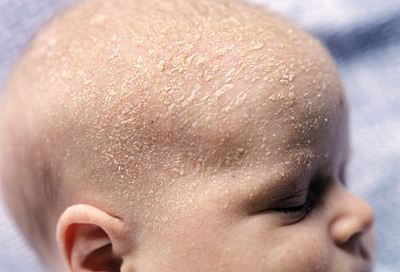Cradle Cap in Infants

What is cradle cap?
Cradle cap is the flaky, dry skin that looks like dandruff or thick, oily, yellowish or brown scaling or crusting patches in many babies Doctors call it infantile seborrhoea dermatitis, and it's very common. Cradle cap isn't cute, looks unsightly but it's harmless. It shows up most often in the first few months of life and usually clears up on its own in about six to 12 months – although some children have it for longer. Cradle cap may even occur around your baby's ears or eyebrows, on his eyelids, or even in his armpits and other creases.
What causes cradle cap?
While there is not a definitive answer on the cause of cradle cap, there are two main beliefs doctors and experts have:
i.) Overactive Sebaceous Glands: Some experts believe that the hormones a baby receives from his mother at the end of pregnancy over stimulate the baby's oil-producing (seborrheic) glands and it often results in cradle cap.
ii.) Fungal Infection: A fungal condition is another belief on the cause of cradle cap, which is suggested to be the result of the mother being given antibiotics prior to childbirth, or the baby having them. Antibiotics are designed to wipe out bad bacteria but also do the same for good bacteria. This can result in an overgrowth of bad bacteria, leading to fungal infections like thrush, or in this case, cradle cap.
Babies are as precious as they are innocent and defenceless too, therefore it may be more than a little alarming for new mothers when their babies develop discoloured, scaly, crusty patches over their soft new skin. You can ignore it as it does not hurt the baby, however if you are concerned that it will spoil your precious baby pictures you may want to get it treated. Rest assured that it is not contagious, does not suggest that the baby hygiene is not being maintained and it probably doesn't bother your baby at all.
Can Cradle Cap be treated at home?
Yes, there are home remedies available that are relatively simple and can effectively be used to treat cradle cap. Try to be as close to natural products as possible and never leave any product on your baby’s skin longer than necessary as it may irritate baby’s tender skin. Remember to consult your paediatrician before using anything on your baby.
1. Good old coconut oil, readily available in most homes, works quite well. Gently massage in some coconut oil into the baby’s scalp with your finger tips and brush using a soft baby brush to lift off the crusts. Olive Oil or jojoba oil may be used too. Remember to wash it the oil off as quickly as possible as leaving it on for a long time might give baby a bad rash on the face.
2. Use a mild shampoo your baby’s scalp regularly (every alternate day or even daily, if you want to) until the flakes fall off. Remember to wash off the shampoo well each time. If this doesn’t work, you may try using a gentle anti –dandruff shampoo after consulting with your doctor.
3. Vaseline petroleum jelly applied on the scalp has been said to work wonders too. Apply a thin layer on to the scalp and leave it on for some time. It lifts of the scaly crusts effectively and effortlessly. Consult your doctor before using it though.
4. There are shampoos specially available for treating cradle cap that you doctor may suggest to you.
5. It is important not to pick and peel off at the dry crust and flakes, however tempting it might be, because it may cause an infection.
Is it necessary to see a doctor?
Yes, it is. Especially when:
1. The cradle cap is severe, if there is any bleeding, or if it spreads beyond your baby's scalp like behind the ears, eyebrows, face and other body creases.
2. If it is showing eczema like symptoms.
3. If you have been using any shampoo or oil for a long time, ineffectively.
- Veena ShyamRaja



.webp)
